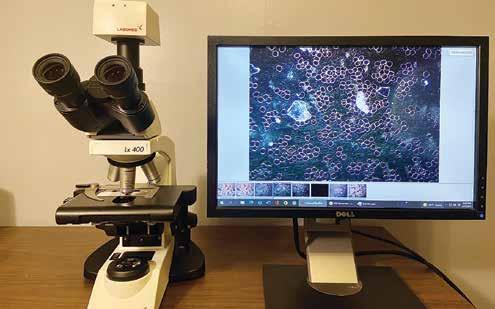
2 minute read
therapy spotlight
Darkfield Microscopy
May Identify Potential Health Problems
Darkfield microscopy, also known as live blood cell analysis, involves the study of blood as it was when circulating in the body and allows observation of the condition of its relationship to vitamins, minerals, antioxidants and enzymes. A dark field microscope is designed to permit diversion of light rays and illumination of the sample from the side, so that details appear light against a dark background, as opposed to light passing straight through the specimen. If bright lights from the microscope pass directly through the specimen, the heat from the light source will kill the red blood cells faster. Also, by diverting the light rays, a greater amount of depth and details can be viewed. Darkfield microscopy allows a health professional to evaluate the size, shapes, movement and other properties of individual blood cells, indicating nutritional conditions which can adversely affect a person’s health. The U.S. Food and Drug Administration does not approve of dark field microscopic blood analysis. However, viewing a fresh, natural blood sample not altered with stains with the technology of a dark field microscope will reveal conditions of the blood not normally considered during the diagnosis of a normal blood test performed in a doctor’s office or a lab. Some health professionals have found that the use of live blood cell analysis allows inspection of cellular dynamics of blood that normally escape analysis or diagnosis using common medical laboratory blood tests.
Live blood cell analysis is carried out by placing a drop of blood from the fingertip on a microscope slide under a glass cover slip to keep it from drying out. The slide is then viewed at high magnification with a microscope that forwards the image to a monitor. Both practitioner and patient can then see the blood cells, and the results are used as a basis for analysis.
The advantage of this analysis over standard blood tests, which detect chemical changes in the blood, is the ability of darkfield microscopy to detect nutritional disorders sooner, when the problem is in its infancy. By monitoring the blood’s condition, a health professional can assist in “balancing” the blood by giving dietary and lifestyle recommendations which can enhance health.
The fastest way to detect specific nutritional deficiencies is by examining the size and shape of the blood cells, which can indicate which enzymes and nutrients are missing or are in short supply within the body. We can observe the changes that occur in the blood with the proper use of enzymes, supplements and appropriate diet and exercise. Proponents say that no other test is as effective as live blood cell analysis to illustrate the effects of these changes.
For more information, call Kathleen I Gregg, ND, at 517-641-8000 or visit HealthMattersMI.com. See ad page 25.

For centuries, people have used chaga mushrooms for medicinal purposes. Packed with antioxidants, its extract may fight cancer, chronic inflammation, improve blood sugar and cholesterol levels. Order your Immune-Boosting Superfood today!
Call 906-282-0787 Now! We make 100% all natural products for helping and promoting better health and skin. We have several doctors who not only carry our products but use them as well. We are state certified, state inspected, and THE ONLY Chaga facility licensed in the U.P.











